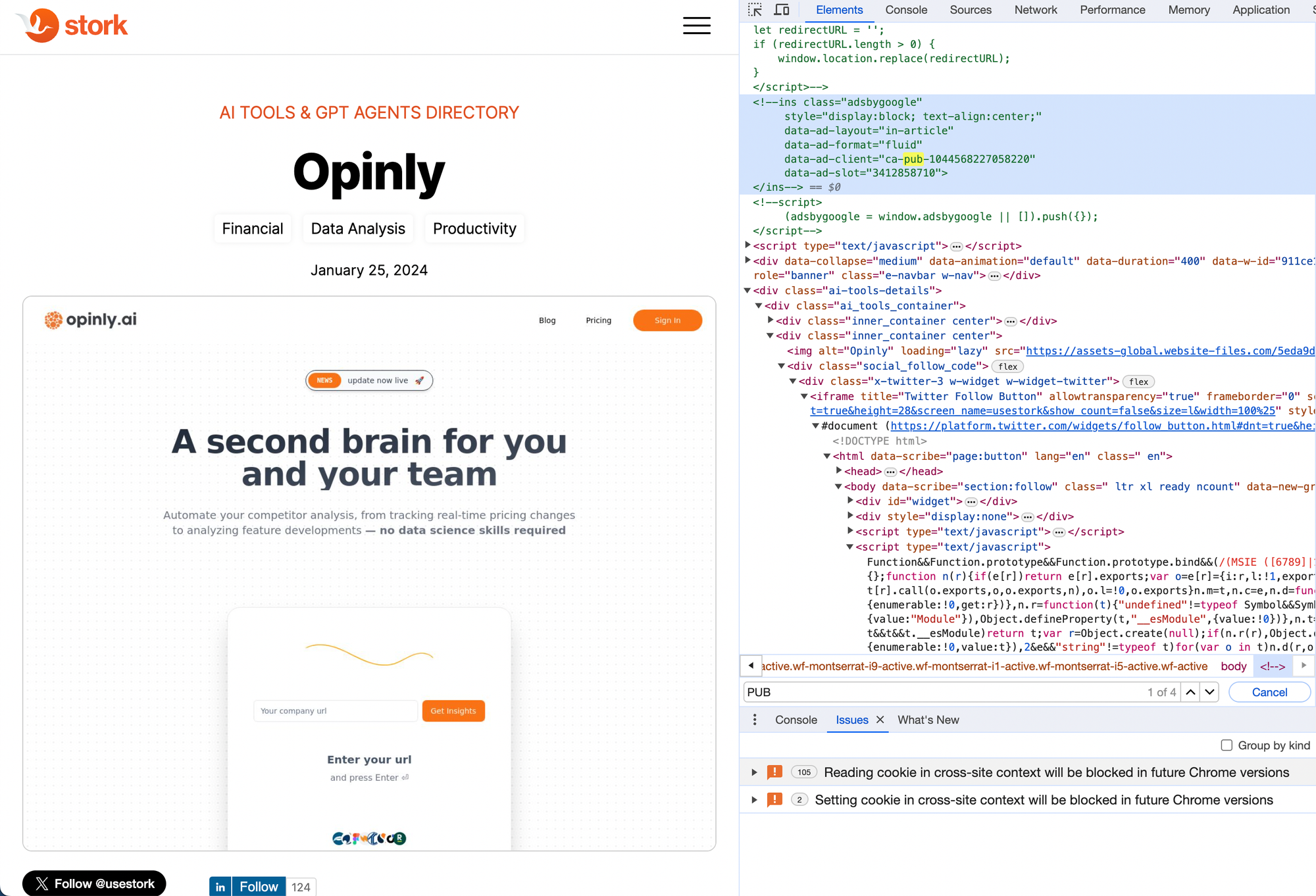Reverse Engineering AdSense
Discover the full extent of your competitor's digital portfolio by reverse engineering Google AdSense

In the competitive realm of digital marketing, gaining an edge often means understanding not just your own business, but also what moves your competitors are making. We’re excited to reveal a method that sheds light on this very aspect, focusing specifically on reverse engineering Google AdSense sites. This approach is not just free; it’s a strategic move to uncover the diverse projects and strategies your competitors are investing in, including detailed insights into their domain information.
What Can You Gain from This Tutorial?
Discover the full extent of your competitor’s digital portfolio by uncovering all websites and domain names linked to their Google AdSense PUB ID.
Understanding AdSense and Its Uses on Web Sites
Google AdSense is a powerful platform that enables website publishers to monetize their content through targeted advertising. By integrating AdSense into their websites, publishers can generate revenue from online ads that are specifically tailored to their audience. The key to this process is the AdSense ID, a unique identifier that tracks and optimizes ad performance across websites.
AdSense works by using sophisticated algorithms to match ads with the content of a website, ensuring that the ads are relevant and engaging for the site’s visitors. This relevance boosts click-through rates, leading to increased revenue for the publisher. For websites, this means a steady stream of income that can support further content development and site improvements.
The AdSense ID is an essential part of the AdSense account, serving as the linchpin for tracking ad impressions, clicks, and earnings. By leveraging this ID, publishers can gain valuable insights into how their ads are performing and make data-driven decisions to enhance their ad strategies. In essence, AdSense transforms websites into revenue-generating platforms by delivering targeted ads that resonate with their audience.
The Role of AdSense ID in Tracking and Optimization
The AdSense ID is a critical tool for tracking and optimizing ad performance on websites. This unique identifier allows publishers to monitor key metrics such as ad impressions, clicks, and earnings, providing a comprehensive view of their ad campaigns’ effectiveness. By analyzing this data, publishers can identify trends, measure success, and make informed decisions to optimize their ad strategies.
One of the significant advantages of the AdSense ID is its ability to link multiple websites to a single AdSense account. This feature enables publishers to manage their ad campaigns across various sites from a unified dashboard, simplifying the process of tracking and optimizing ad performance. By using the same AdSense ID on multiple sites, publishers can gain a holistic view of their ad portfolio and identify opportunities for improvement.
This centralized approach to ad management allows publishers to compare performance across different sites, identify high-performing content, and replicate successful strategies. Ultimately, the AdSense ID empowers publishers to maximize their ad revenue by providing the data and tools needed to fine-tune their ad campaigns.
Step-by-Step Guide
1. Selecting a Target Website
Concentrate on a competitor's website that stands out due to its exceptional traffic, engagement levels, or distinct value proposition. This site is likely a crucial asset within your competitor's array of digital properties.
For instance, in our analysis, we examine reviews on opinly.ai to determine if the reviewers are associated with any other platforms, with a special focus on stork.ai.
Inspect the site's code using the browser's 'Inspect Element' feature, and locate the Google AdSense PUB ID by pressing 'Cmd' (Mac) or 'Ctrl' (Windows) along with 'F' to open the search function, then type 'pub'. This action unveils the key to exploring the full array of your competitor's online ventures.

2. Compiling and Using Reverse Analytics Data
Reverse analytics data can be a goldmine of information when it comes to understanding a competitor’s online presence and strategies. One effective method to compile this data is by using reverse analytics search tools. These tools can identify websites that share the same AdSense ID or Google Analytics ID, revealing a network of sites connected to a single entity.
By analyzing this reverse analytics data, publishers can uncover valuable insights into their competitors’ digital strategies. For instance, they can identify which websites are part of a competitor’s portfolio, understand the distribution of their ad campaigns, and spot potential gaps in their strategy. This information can be instrumental in developing targeted ad campaigns that capitalize on these gaps.
Using reverse analytics data, publishers can also benchmark their performance against competitors, identify best practices, and refine their own strategies. This proactive approach to data analysis can lead to more effective ad campaigns, improved online presence, and ultimately, a stronger competitive position in the digital marketplace.
3. Leveraging Host.io
With the PUB ID obtained, enter 'host.io/adsense/pub-your-16-digit-code' into your browser's address bar, substituting 'pub-your-16-digit-code' with the actual PUB ID (e.g., 'pub-1044568227058220'). This query uncovers not only the initial site but also every site connected to the same AdSense account, providing a comprehensive overview of your competitor's digital footprint.
4. Google Analytics Results
In this instance, no additional sites are using the same ID, but I encourage you to test it out for yourself.

Case Studies and Examples of Successful Reverse Engineering
Reverse engineering using AdSense and Google Analytics data has proven to be a successful strategy for many website publishers and digital marketing agencies. For example, a publisher might use reverse analytics data to identify a competitor’s AdSense ID and track their ad performance across multiple sites. By analyzing this data, the publisher can gain insights into the competitor’s ad strategy, such as which types of ads perform best and which sites generate the most revenue.
In another case, a digital marketing agency might use reverse analytics data to optimize their clients’ ad campaigns. By identifying gaps in competitors’ strategies, the agency can develop targeted ad campaigns that address these gaps and improve their clients’ online presence. This approach not only enhances the effectiveness of ad campaigns but also provides a competitive edge in the digital marketing landscape.
These case studies highlight the potential of reverse engineering to uncover valuable insights and drive strategic decision-making. By leveraging AdSense and Google Analytics data, publishers and agencies can develop more effective ad campaigns, improve their online presence, and achieve better results.
Overcoming Challenges and Limitations in Reverse Engineering
While reverse engineering using AdSense and Google Analytics data offers significant benefits, it also comes with its own set of challenges and limitations. One of the primary challenges is ensuring the accuracy of the data. Factors such as data quality and sampling bias can affect the reliability of the insights gained from reverse engineering.
Another limitation is the complexity of the data. Analyzing and interpreting large volumes of data can be daunting, requiring specialized tools and techniques. Website publishers and digital marketing agencies may need to invest in advanced analytics tools and develop expertise in data analysis to effectively leverage reverse engineering.
Despite these challenges, the potential benefits of reverse engineering are substantial. By using the right tools and techniques, publishers and agencies can overcome these obstacles and gain valuable insights into their competitors’ strategies. This, in turn, can inform the development of targeted ad campaigns that drive better results and enhance their competitive position in the digital marketplace.
In conclusion, reverse engineering using AdSense and Google Analytics data is a powerful strategy for gaining insights into competitors’ online presence and strategies. By understanding the challenges and leveraging the right tools, publishers and agencies can unlock the full potential of this approach and achieve greater success in their digital marketing efforts.
Ethical Considerations and Strategic Use
While this method opens up a treasure trove of competitive intelligence, it's essential to approach this information ethically and strategically. The goal is to inspire innovation and strategic planning within your own projects.
Leverage this method to stay one step ahead in the digital marketing game, ensuring your projects are not just competitive but also innovative and responsive to market dynamics.




